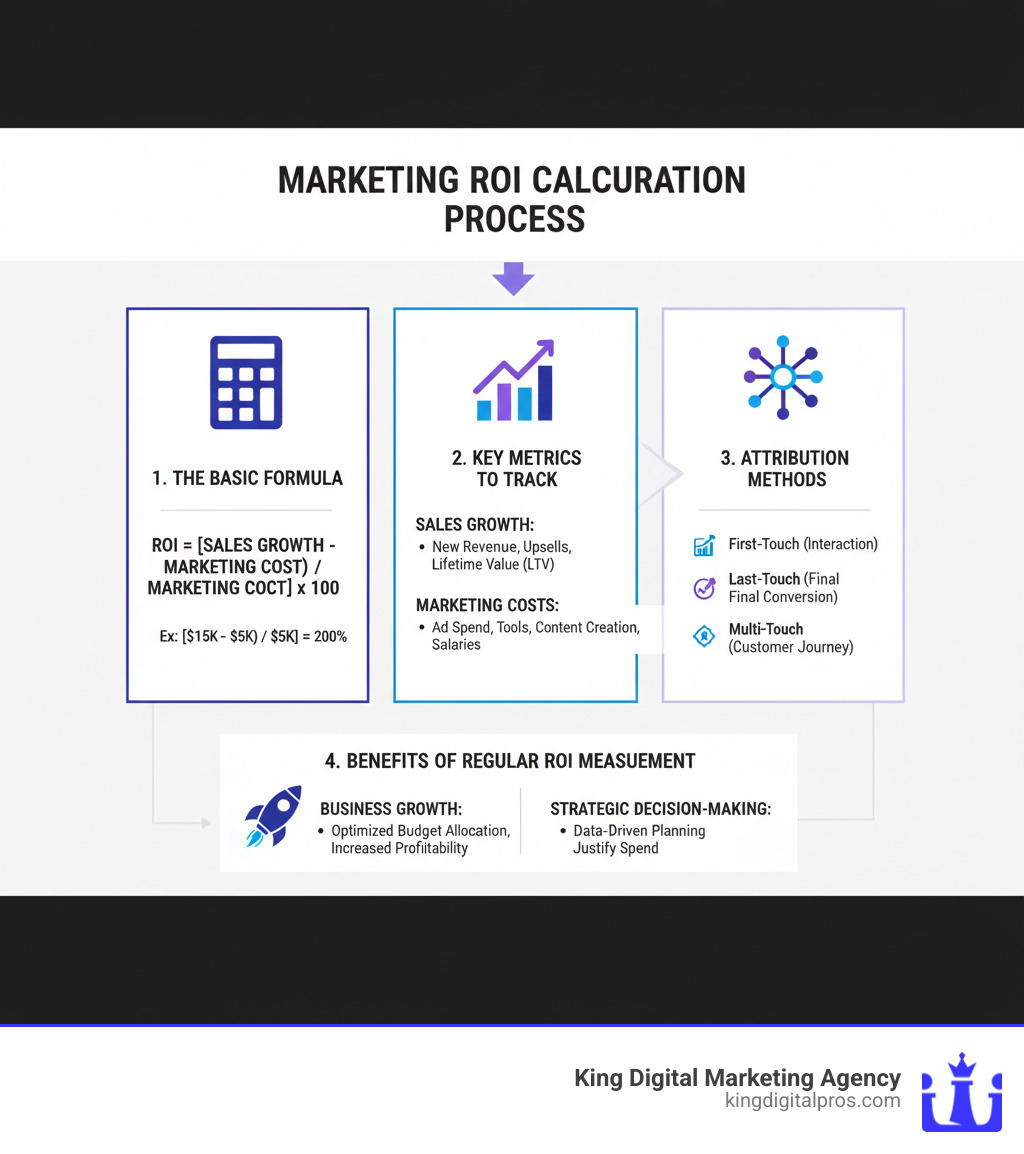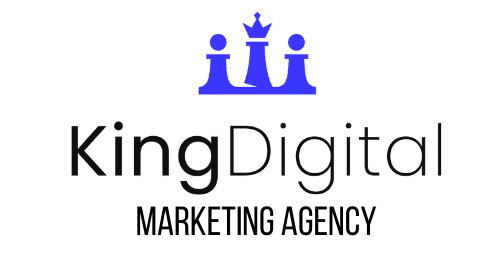How to measure marketing roi: Unlock 5:1 Potential
Introduction: What is Marketing ROI and Why It’s Your Most Important Metric
How to measure marketing roi is straightforward: subtract your marketing costs from the sales growth generated, then divide by the marketing costs. The result is your return on investment.
The Essential Formula:
- ROI = [(Sales Growth – Marketing Cost) / Marketing Cost] x 100
- Example: If you spent $5,000 on marketing and generated $15,000 in new sales, your ROI is 200%. [($15,000 – $5,000) / $5,000] x 100 = 200% ROI.
- This means you earned $2 for every $1 spent.
Marketing spend often represents a significant portion of a business’s budget. Yet, many marketers struggle to track their ROI confidently. Without this crucial metric, you can’t justify your budget, optimize your channel investments, or prove that marketing is driving real business growth.
The good news is that marketing ROI is completely measurable. Tracking it transforms marketing from a cost center into a profit center, enabling data-driven decisions that answer the critical question: “Is this marketing working?”
For local businesses, every marketing dollar must count, whether it’s driving traffic from Google Maps, ad clicks, or email campaigns.
I’m Bernadette King, founder of King Digital Marketing Agency. I’ve spent my career helping businesses track and improve how to measure marketing roi. In this guide, I’ll walk you through the formulas, metrics, and strategies you need to calculate your true marketing return and use that data to grow.

The Essential Formulas for Calculating Marketing ROI

Understanding how to measure marketing roi begins with the fundamental math. The goal is to determine if your marketing investment is generating more revenue than it costs. Let’s break down the formulas, from the simplest approach to a more refined calculation.
A simple formula for how to measure marketing ROI
The most direct way to calculate marketing ROI measures the sales lift from a specific campaign. This simple ROI formula provides an immediate snapshot of performance:
ROI = [(Sales Growth – Marketing Cost) / Marketing Cost] x 100
Let’s use a real-world example. A local Albuquerque bakery launches a Facebook ad campaign for its custom cakes.
- Sales Growth: $8,000 in new orders.
- Marketing Cost: $2,000 for ad spend and design.
Plugging these into the formula:
ROI = [($8,000 – $2,000) / $2,000] x 100 = 300%
This result means for every $1 invested, the bakery generated $3 in additional sales. This step-by-step calculation example clearly shows when marketing is effective. This formula is ideal for short-term campaigns with trackable outcomes, like email promotions or paid ads. For a deeper dive, Investopedia offers a great resource on how to calculate the return on investment (ROI) of a marketing campaign.
Accounting for Organic Growth
A potential blind spot in the simple formula is that it doesn’t account for sales you would have made anyway. This is organic sales growth. Ignoring it can inflate your marketing ROI. To get a true measure of your campaign’s value, you must isolate the campaign impact.
This is where campaign-attributable ROI is useful. The adjusted formula is:
Campaign-Attributable ROI = [(Sales Growth – Organic Sales Growth – Marketing Cost) / Marketing Cost] x 100
Let’s take a calculation example with organic lift. A home services business with a typical 3% monthly organic growth launches a $5,000 Google Ads campaign. Total sales increase by $10,000 that month from a baseline of $50,000.
- Organic Growth: $50,000 x 0.03 = $1,500
Now, apply the adjusted formula:
ROI = [($10,000 – $1,500 – $5,000) / $5,000] x 100 = 70%
Without accounting for organic growth, the ROI would have appeared to be 100%. This more accurate 70% figure provides a truer picture of the campaign’s performance. This level of precision is crucial for making smart budget allocation decisions and having honest conversations about what truly drives growth.
Key Metrics & Concepts: A Deeper Dive into ROI Analysis

To truly understand how to measure marketing roi, you need to look beyond a single formula. A full picture requires tracking several Key Performance Indicators (KPIs) that reveal both immediate wins and long-term value. Let’s explore the most important ones.
ROI vs. ROAS: Understanding the Difference
Many marketers use ROI and ROAS (Return on Ad Spend) interchangeably, but they measure different things.
ROAS is laser-focused on advertising. It answers: for every dollar spent on an ad, how much revenue did it generate? If you spent $100 on ads and made $400 in sales, your ROAS is 4:1. It’s perfect for optimizing individual ad campaigns.
Marketing ROI takes a broader view. It considers all marketing expenses – ad costs, salaries, software, content creation – and measures the profitability of the entire marketing function. We use ROAS to fine-tune specific campaigns, like in our PPC Management services, and ROI to assess if our overall strategy is driving business growth.
Customer Lifetime Value (CLV) and Customer Acquisition Cost (CAC)
To build a healthy business, you must understand the long-term value of your customers. That’s where Customer Lifetime Value (CLV) and Customer Acquisition Cost (CAC) come in.
CLV is the total revenue you expect from a customer over their entire relationship with your business. It shifts focus from a single sale to the long-term worth of a customer.
CAC is what you spend to acquire a new customer. To calculate it, divide your total marketing and sales expenses by the number of new customers acquired in a period.
The magic happens when you compare CLV and CAC. If your CLV is significantly higher than your CAC, you have a sustainable business model. If it costs you $50 to acquire a customer (CAC) who will spend $250 over their lifetime (CLV), you’re in a great position. Brand loyalty is key to this equation, as loyal customers buy more often and refer others, increasing CLV while lowering CAC. To estimate what your leads are worth, you can use our Lead Value Calculator.
Other Critical Marketing Metrics
Several other KPIs provide diagnostic insights into your marketing funnel.
- Cost per Lead (CPL): What you pay to generate a new lead. It helps diagnose issues in your lead-to-customer pipeline.
- Conversion Rate: The percentage of users who take a desired action (e.g., visitor to lead, lead to customer). Small improvements here can dramatically impact your bottom line. Our Digital Marketing Conversion Rate guide offers strategies for improvement.
- Average Order Value (AOV): How much customers spend in a single transaction. Increasing AOV is a fast way to boost revenue from your existing traffic.
- Lead-to-Customer Rate: The percentage of leads that become paying customers. This metric reveals the quality of your leads and the effectiveness of your sales process.
As noted by Harvard Business Review, sophisticated marketers track multiple metrics to understand the full customer journey and pinpoint where to optimize for maximum impact.
How to Measure Marketing ROI in a Multi-Touch World

The modern customer’s path to purchase is rarely linear. They might see a social media ad, visit your website, and later search for you on Google Maps before making a purchase. This complexity makes figuring out how to measure marketing roi a significant challenge, often due to data silos where information from different platforms remains disconnected.
The Challenge of Attribution
The core problem is attribution: when a customer interacts with multiple marketing channels, which one gets credit for the sale? Traditional models offer different solutions:
- Last-touch attribution gives 100% credit to the final interaction before a sale. It’s simple but ignores earlier touchpoints.
- First-touch attribution credits the very first interaction.
- Linear attribution spreads credit equally across all touchpoints, while time decay models give more weight to recent interactions.
Instead of relying on a single model, it’s best to analyze your data through multiple lenses. Comparing what last-touch (closing channels) and first-touch (findy channels) models reveal provides a more complete picture. As the Harvard Business Review highlights, different perspectives uncover different truths about marketing effectiveness.
Measuring ROI for Different Marketing Channels
Each channel requires a custom measurement approach.
- Email Marketing: Often boasts the highest ROI, with some studies showing a return of $38 for every $1 spent. It’s easily tracked with metrics like open rates, click-through rates, and conversions from specific emails.
- Social Media Marketing: Serves to both drive direct sales (measurable with ROAS) and build brand awareness. We track hard numbers like traffic and sales from our Services Social Media Advertising and softer metrics like engagement and follower growth.
- Digital Advertising: Platforms like Google Ads offer robust tracking, making it straightforward to calculate ROAS and campaign performance. Video ads are particularly effective, with many marketers reporting strong ROI.
- Event Marketing: ROI can be measured by tracking leads generated, social media buzz, website traffic spikes, and new sales originating from event connections.
How to measure marketing ROI for SEO and Content Marketing
SEO and content marketing are long-term investments. A blog post published today can generate leads for years. The Content Marketing Institute notes that while content ROI can be a mystery, a long-term perspective is key, along with considering non-financial returns.
Key indicators include:
- Organic Traffic Growth: An increase in organic search traffic and keyword rankings signals growing visibility.
- Lead Generation from Content: Tracking how many leads originate from specific blog posts or guides provides concrete data. Research shows 82% of marketers who blog see positive ROI.
- Brand Awareness: Content builds authority and trust. While harder to quantify, metrics like increased branded searches and customer mentions are part of content’s true ROI.
The power of content and SEO, which we specialize in through our Services SEO Services, lies in their compounding effect. They continue to deliver value long after the initial investment, leading to substantial ROI growth over time.
Improving Your Results: Strategies and Tools for Better ROI

Understanding how to measure marketing roi is the first step. The real value comes from using that data to make smarter decisions and drive continuous improvement.
Actionable Strategies to Boost Your Marketing ROI
- Set clear goals: Define what success looks like for each campaign – whether it’s leads, sales, or brand awareness – to create a clear target for optimization.
- Focus on high-performing channels: Analyze your ROI data to identify which channels deliver the best results, and allocate your budget accordingly.
- A/B testing campaigns: Systematically test different headlines, images, and calls to action. Small improvements can lead to significant ROI gains over time.
- Personalization: Tailor content to specific customer segments based on location, behavior, or purchase history to increase engagement and conversions.
- Improve landing pages: Optimize your landing pages for clear messaging and a simple conversion path. Our Conversion Optimization Complete Guide offers detailed strategies.
- Nurture leads: Use email sequences and retargeting to stay engaged with prospects who aren’t ready to buy immediately. This builds trust and often leads to higher-quality customers.
Essential Features of Marketing ROI Tools
The right software makes measuring ROI much easier. Look for these key features:
- Full customer journey tracking: The ability to see every touchpoint across all channels and devices.
- CRM integration: Connects marketing activities to sales revenue, providing a complete financial picture.
- Real-time data dashboards: Allows for immediate campaign monitoring and quick adjustments.
- Usability: An intuitive interface that your team will actually use.
- Offline conversion tracking: Crucial for local businesses, this connects online efforts to in-store visits. Our Best Lead Tracking Services help bridge this gap.
Types of Tools to Consider
Most businesses can effectively measure ROI with a few core platforms:
- Web analytics platforms: Tools like Google Analytics are foundational for tracking website traffic, user behavior, and online conversions.
- All-in-one business dashboards: Consolidate data from multiple sources (e.g., Google Ads, Salesforce, QuickBooks) into a single view.
- CRM systems: Track customer interactions and sales, closing the loop on ROI by linking revenue to specific campaigns.
- Marketing automation platforms: Execute and track campaigns, providing detailed performance reports.
- Specialized ROI tracking software: Built for advanced attribution, these tools connect revenue back to the marketing touchpoints that initiated the customer relationship.
- Spreadsheet software: For smaller businesses, a well-organized spreadsheet can be a flexible and powerful (though manual) ROI tracking tool.
Our Must Have Marketing Tools guide provides a comprehensive look at the technologies that power modern marketing.
Frequently Asked Questions about Marketing ROI
What is considered a ‘good’ marketing ROI?
While there’s no single answer, some general benchmarks can be helpful. A 5:1 ratio ($5 in revenue for every $1 spent) is widely considered strong. A 10:1 ratio is exceptional. Conversely, a 2:1 ratio is often just breaking even once you factor in the cost of goods and other business overhead.
However, a “good” ROI depends heavily on your industry, business maturity, and campaign goals. A new business might accept a lower initial ROI to gain market share, while an established company should aim for higher returns. For more context, WebStrategies Inc. provides valuable insights on industry-specific benchmarks.
How do you measure the ROI of brand awareness campaigns?
Brand awareness campaigns don’t always lead to immediate sales, but their impact is measurable through proxy metrics that predict future revenue.
Key indicators include:
- Branded search volume: An increase in people searching for your business name directly.
- Share of voice: Your brand’s share of the conversation in your industry compared to competitors.
- Social media engagement: Growth in likes, shares, comments, and followers.
- Website traffic: An increase in direct traffic or visitors from brand-related searches.
These metrics are leading indicators of brand strength. While they don’t provide a direct dollar-for-dollar ROI, they demonstrate the long-term impact on sales that brand awareness creates.
How often should I calculate marketing ROI?
The key is to do it regularly. The ideal frequency depends on your activity level.
- Campaign-based: Calculate ROI immediately after a specific campaign ends for quick feedback.
- Monthly or quarterly: Review your overall marketing performance to align with business reporting cycles and make strategic adjustments.
- Real-time: For ongoing digital ad campaigns, use real-time dashboards to monitor performance and optimize continuously, preventing wasted ad spend.
Whether you’re a local business in Taos running a few campaigns or a larger company with daily ad spend, the principle is the same: consistent measurement keeps your marketing accountable and effective.
Conclusion: From Calculation to Growth
We’ve covered the essential formulas for how to measure marketing roi, the nuances of attribution, and the tools that simplify the process. The key takeaway is that marketing ROI is more than a number – it’s a strategic compass for growing your business.
By regularly calculating ROI and understanding deeper metrics like Customer Lifetime Value and Customer Acquisition Cost, you transform marketing from an expense into a proven profit driver. You gain clarity on what’s working, what isn’t, and where to invest your next dollar for the greatest impact.
For local businesses, connecting these digital efforts to real-world results is crucial. At King Digital Marketing Agency, we specialize in optimizing Google Business Profiles and map listings to ensure customers in Albuquerque, Rio Rancho, and Santa Fe can find you. We bridge the gap between online visibility and measurable revenue.
Data-driven decision making removes the guesswork from marketing. You no longer have to hope your budget is well-spent – you’ll know. That knowledge is what empowers sustainable growth.
Ready to open up your marketing’s full potential? Start measuring, optimizing, and growing today.
Try our free Marketing ROI Calculator to get started and take the first step toward marketing that truly works for you.

